Proudly announcing PurAID® Water
Content
We are proud to present PurAID® Water, our new solution, which is making life easier and healthier for thousands of women and children. Our healthy drinking water container is easy to install, relocate and provides residents with high-quality drinking water. The first project is planned to be realized in Ghana by our Ghanaian local partner.

2.1 billion people worldwide cannot access healthy, clean drinking water. This affects the lives of the children who live in these areas. When there is no water in or near homes and it has to be collected from far away, the women and girls living there mostly pay for water with their time and lost opportunities. Walking miles to fetch water puts a disproportionate burden on women and children, especially girls, who are responsible for providing water for the family and who are deprived of schooling because of the time spent carrying water every day.
Ensuring safe, clean and drinkable groundwater supplies for communities across Africa and worldwide is a growing concern due to deteriorating groundwater quality, aging infrastructure, increasing population growth and lack of adequate capital injection into the treatment sector. Due to the high risk of exposure to Arsenic, Iron and Manganese contamination in groundwater supplies, point-of-use (POU) water treatment is gaining global acceptance.
PurAID® WATER, an Independent Drinking Water Provider (IDWP) Concept, as a sustainable approach to point-of-use drinking water treatment solutions. The Independent Drinking Water Provider Concept aims at:
- Discouraging the consumption of sachet water in communities
- Provision of new borehole water supply facilities and rehabilitation of existing facilities
- Through our local partner in Ghana, increasing access to clean and sustainable borehole water supply as alternative to sachet water consumption in 300 communities across 10 regions in Ghana by 2030
- Involving marginalized communities in groundwater-related decision-making processes,
- Establishing partnerships with relevant stakeholders, including government agencies, NGOs, community groups, research institutions and private sector entities
- Contributing to public health by reducing waterborne diseases and health risks associated with contaminated groundwater.
The Independent Drinking Provider Concept utilizes crystalline aqueous cerium powder on polymeric support (AsMET) for the removal of Arsenic from groundwater supplies to less than 1µg/l. It also provides the removal of Iron and Manganese from groundwater supplies up to 200µg/l and 50µg/l respectively using naturally occurring zeolite cation exchange potential (ZMET).
In addition to its positive physiological effects, we can also minimise the environmental impact by replacing the use of single-use plastic bottles and powering the container with solar panels, a renewable energy source. The Independent Drinking Water Provider Concept is a sustainable and low-power solution and a promising sustainable approach first for Ghana as a test venue. According to our plans, PurAID® Water is a solution for every community needing safe drinking water access.
Please find the video of our concept below:
Arsenic-removal tanks
Intro
Our company placed its PuraWell arsenic-removing tank at the kindergarten of Rinyaújlak fitted to a wall fountain.
Properties
- Subtitle
Vietnam Arsenic removal
Intro
Our expansion into the Far East began with Vietnam, where arsenic contamination of drinking water is a huge problem
Properties
- Subtitle
Development of control rod used in reactor technology
Intro
In 2019, we developed a reactor technology control rod for the Eötvös Lóránd Research Network - Energy Science Research Center, in which the desired parameters were achieved by blasting, while the gas tightness was achieved by electron beam welding.
Properties
- Subtitle





